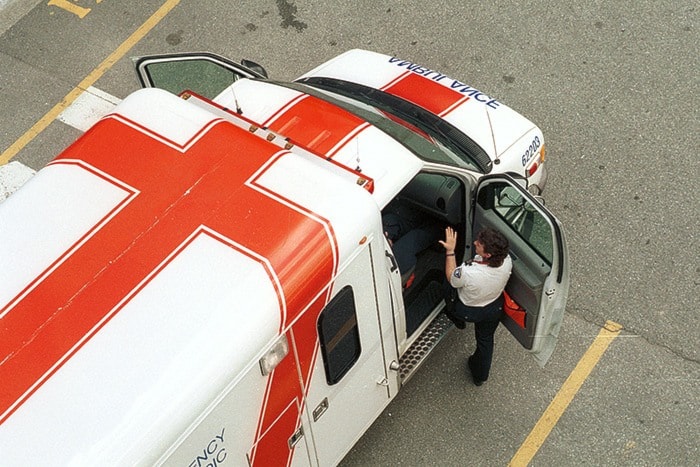While some Metro Vancouver firefighters worry about a new B.C. Ambulance Service policy that reduces the number of emergency responses, local fire chiefs say there will be little impact here.
“Very little,” said Pitt Meadows fire chief Don Jolley.
“Pitt Meadows has never and currently doesn’t respond to all of these minor incidents that other cities are going to. It’s had very little, if any effect on our organization at all.”
A reallocation of ambulance service last fall shifted dozens of call types – often for broken bones or other incidents where the patient is medically stable – so that those ambulances now roll at posted speed limits without lights and siren, rather than Code 3 at high speed.
That could lead to longer wait times for firefighters who can arrive first, then wait for ambulance crews to take over.
Unlike some cities in Metro Vancouver, where fire departments respond to all medical emergencies, Maple Ridge and Pitt Meadows firefighters respond to only serious medical emergencies that are life-threatening. As a result, they don’t have to wait for ambulances that now are responding routinely to more medical incidents.
Maple Ridge fire chief Dane Spence said the same thing.
“Generally, we don’t go to those calls that they have already downgraded. Our calls have actually gone down.”
But Jolley pointed out fire departments and cities aren’t forced to attend to medical calls and can opt out from responding to even any medical emergencies. Salmon Arm’s fire department for instance, doesn’t respond to any medical calls.
“Fire departments voluntarily choose to go to those calls,” Jolley added.
And if they choose to do so, they shouldn’t complain because they have to wait for ambulances arrive to take over the scene.
He added a change in social expectations and culture is challenging all emergency responders.
“Twenty years ago, people wouldn’t have called us for half the things,” said the former Vancouver paramedic.
Now, parents call an ambulance if a child twists his or her ankle on the soccer pitch.
“The emergency department is full of people with headaches. Our whole culture has changed.”
Jolley welcomes the change in ambulance policy.
“Personally, there are ambulances responding to calls that are non-emergency. I support the majority of what they’re doing and why they’re doing it.”
Jolley added that if an ambulance responds non-emergency, so too should firefighters. They could be legally at risk if an accident happens while they’re rushing to a non-emergency call.
Currently, medical emergencies make up about 30 per cent of Maple Ridge and Pitt Meadows fire department responses. But in some cities in Metro Vancouver, that can be 60 to 70 per cent.
Spence said Maple Ridge’s policy of responding only to serious, life-threatening calls has been present for decades, from when it was solely a paid-on-call service.
“That’s been our council’s directive from Day 1.”
But older cities historically have more fire halls, allowing quicker response, making it easier for fire trucks to get to calls.
He said the new policy was “very poorly communicated.”
Several Metro Vancouver mayors say the service change amounts to downloading of costs by the province because firefighters who respond first end up waiting longer with patients, sometimes incurring more overtime as well.
“They are reducing quality of service,” Port Coquitlam Mayor Greg Moore said. “Sometimes the patient’s family has driven someone to the hospital, which is just not appropriate.”
B.C. Emergency Health Services, maintains the changes are not a money-saving measure but to improve care by speeding response to those in most urgent need.
Dr. William Dick, vice-president of medical programs at B.C. Emergency Health Services, said there are no plans to exclude fire halls from low priority calls if the local city still wants its firefighters to respond to provide “comfort care” while awaiting an ambulance.
“I will not arbitrarily cut anyone off,” Dick said.”I question the wisdom of spending a really expensive resource when it’s not required medically. But it’s not my decision to make.”
Officials say it’s meant an average of six minutes slower arrival times to those calls, but allowed one minute faster average responses to urgent life-or-death emergencies like heart attacks, while reducing the risk of high-speed crashes between ambulances and other vehicles.
B.C. Professional Fire Fighters Association president Mike Hurley said that doesn’t match what fire department first responders are seeing.
“Our experience in the field is it’s anywhere from 30 to 45 minutes and longer for an ambulance to show up,” Hurley said of the downgraded calls.
“They’ve lessened the service to the citizens of each community.”
He said the types of calls that are no longer dispatched at high speed include serious falls, serious hemorrhages and certain pregnancy calls.
They make up about nine per cent of overall ambulance calls, according to a report on the reallocation plan, and mean 800,000 fewer kilometres of lights-and-siren driving each year.
Dr. William Dick, vice-president of medical programs at B.C. Emergency Health Services, said the changes flow from a rigorous two-year expert review that assessed outcomes for patients and the risks of high-speed ambulance driving.
“It’s safer to the driving public, it’s safer for our paramedics and it’s safer for our patients,” Dick said Wednesday.
He likened the change to hospital triage policies that give the most urgent cases priority ahead of patients who can safely wait longer.
Dick said a rolling analysis of the changes has so far found no change in medical outcomes for patients whose call priority was reduced.
– with files from Jeff Nagel and Diane Strandberg.
